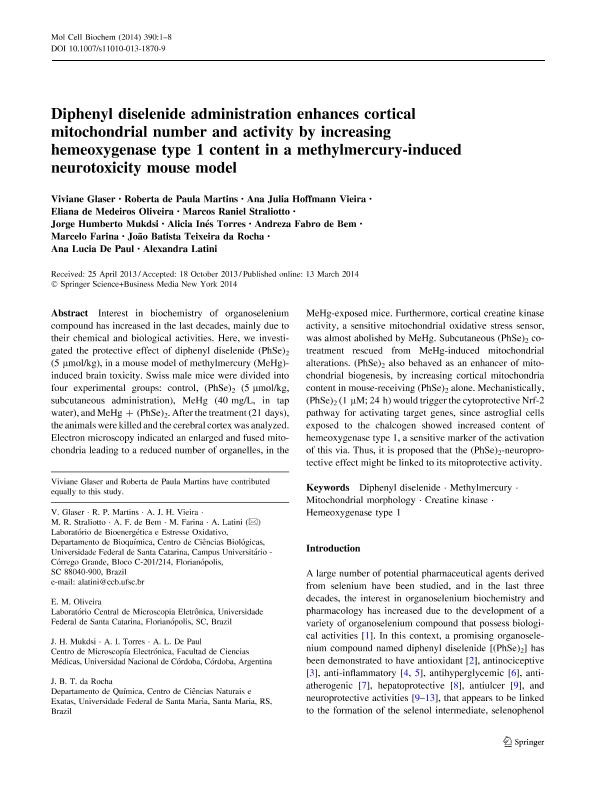Artículo
Diphenyl diselenide administration enhances cortical mitochondrial number and activity by increasing hemeoxygenase type 1 content in a methylmercury-induced neurotoxicity mouse model
Glaser, Viviane; de Paula Martins, Roberta; Hoffmann Vieira, Ana Julia; de Medeiros Oliveira, Eliana; Straliotto, Marcos Raniel; Mukdsi, Jorge Humberto; Torres, Alicia Ines ; Fabro de Bem, Andreza; Farina, Marcelo; Teixeira da Rocha, Joao Batista; de Paul, Ana Lucia
; Fabro de Bem, Andreza; Farina, Marcelo; Teixeira da Rocha, Joao Batista; de Paul, Ana Lucia ; Latini, Alexandra
; Latini, Alexandra
 ; Fabro de Bem, Andreza; Farina, Marcelo; Teixeira da Rocha, Joao Batista; de Paul, Ana Lucia
; Fabro de Bem, Andreza; Farina, Marcelo; Teixeira da Rocha, Joao Batista; de Paul, Ana Lucia ; Latini, Alexandra
; Latini, Alexandra
Fecha de publicación:
03/2014
Editorial:
Springer
Revista:
Molecular and Cellular Biochemistry
ISSN:
0300-8177
e-ISSN:
1573-4919
Idioma:
Inglés
Tipo de recurso:
Artículo publicado
Clasificación temática:
Resumen
Interest in biochemistry of organoselenium compound has increased in the last decades, mainly due to their chemical and biological activities. Here, we investigated the protective effect of diphenyl diselenide (PhSe)2 (5 μmol/kg), in a mouse model of methylmercury (MeHg)-induced brain toxicity. Swiss male mice were divided into four experimental groups: control, (PhSe)2 (5 μmol/kg, subcutaneous administration), MeHg (40 mg/L, in tap water), and MeHg + (PhSe)2. After the treatment (21 days), the animals were killed and the cerebral cortex was analyzed. Electron microscopy indicated an enlarged and fused mitochondria leading to a reduced number of organelles, in the MeHg-exposed mice. Furthermore, cortical creatine kinase activity, a sensitive mitochondrial oxidative stress sensor, was almost abolished by MeHg. Subcutaneous (PhSe)2 co-treatment rescued from MeHg-induced mitochondrial alterations. (PhSe)2 also behaved as an enhancer of mitochondrial biogenesis, by increasing cortical mitochondria content in mouse-receiving (PhSe)2 alone. Mechanistically, (PhSe)2 (1 μM; 24 h) would trigger the cytoprotective Nrf-2 pathway for activating target genes, since astroglial cells exposed to the chalcogen showed increased content of hemeoxygenase type 1, a sensitive marker of the activation of this via. Thus, it is proposed that the (PhSe)2-neuroprotective effect might be linked to its mitoprotective activity.
Archivos asociados
Licencia
Identificadores
Colecciones
Articulos(INICSA)
Articulos de INSTITUTO DE INVESTIGACIONES EN CIENCIAS DE LA SALUD
Articulos de INSTITUTO DE INVESTIGACIONES EN CIENCIAS DE LA SALUD
Citación
Glaser, Viviane; de Paula Martins, Roberta; Hoffmann Vieira, Ana Julia; de Medeiros Oliveira, Eliana; Straliotto, Marcos Raniel; et al.; Diphenyl diselenide administration enhances cortical mitochondrial number and activity by increasing hemeoxygenase type 1 content in a methylmercury-induced neurotoxicity mouse model; Springer; Molecular and Cellular Biochemistry; 390; 1-2; 3-2014; 1-8
Compartir
Altmétricas



